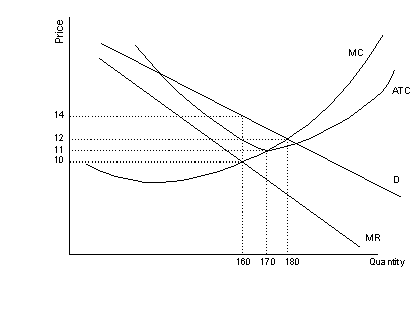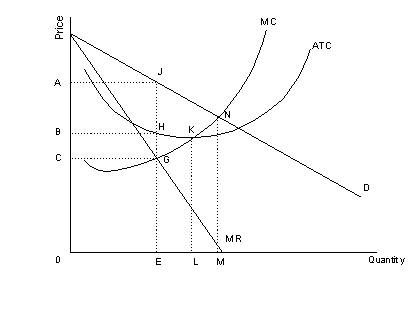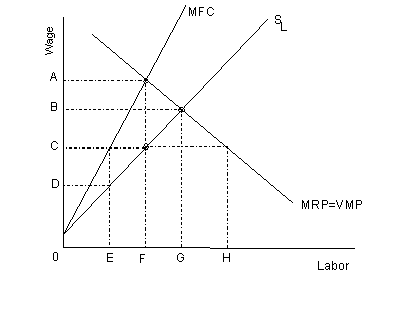Economics 165 Final Exam
Spring
1996
- 1. Microeconomics is the branch of economics that focuses on
- a. national economic activity
- b. individual decision makers and markets
- c. deficit spending
- d. inflation and unemployment
- 2. Allocative efficiency means that
- a. opportunity cost has been reduced to zero
- b. resources are allocated to the use which has the
highest value to society
- c. technological efficiency has not been achieved
- d. only relative scarcity exists
- 3. Operating inside a society's production possibilities
frontier is a:
- a. drawback of capitalism relative to socialism
- b. symptom of inefficiency or idle resources
- c. way to build reserves to stimulate investment and
growth
- d. result whenever the capital stock depreciates
rapidly
- 4. The law of __________________________ is illustrated by
a production possibilities frontier
which is bowed out (concave) from the origin
- a. constant opportunity costs
- b. decreasing opportunity costs
- c. comparative advantage
- d. increasing opportunity costs
- e. of large numbers
- 5. A decrease in consumer preferences for a product, other
things being equal, means
that
- a. supply will decrease
- b. market demand will shift to the left
- c. market demand will shift to the right
- d. quantity demanded will increase
- e. quantity demanded is not a function of price
- 6. An inferior good is a product
- a. that is not expensive
- b. for which there is no demand
- c. for which demand increases as income increases
- d. for which demand falls as income increases
- e. that has an upward-sloping demand curve
- 7. Substitution and income effects of a change in the price
of a good may be used to
explain the
- a. direct relationship between price and quantity
purchased
- b. inverse relationship between price and quantity
demanded
- c. direct relationship between income and demand
- d. direct relationship between price and quantity
supplied
- 8. When there is a shortage in a market
- a. consumers are willing to buy more of the good at the
current price
- b. the equilibrium price is below zero
- c. quantity supplied exceeds quantity demanded
- d. firms are willing to sell more of the good at the
current price
- e. market shortages are not possible
- 9. The price of good X has increased significantly over the
last year. Nonetheless,
suppliers still sell the same quantity each week as last
year. Evidently there has
been
- a. a decrease in demand and an increase in supply
- b. a decrease in demand and a decrease in supply
- c. an increase in demand and an increase in supply
- d. an increase in demand and a decrease in supply
- 10. Price elasticity of demand measures:
- a. the change in quantity supplied to the change in
price
- b. the extent to which a demand curve shifts from the
change in an exogenous
variable (outside factor)
- c. the response between two goods when the price of
one good changes
- d. consumer responsiveness to price changes
- 11. Suppose the price of a certain good fell from $1.00 to
$0.50 and, as a result, the
quantity demanded increased from 500 to 750 units. Over this
range, the demand curve
is:
- a. elastic
- b. perfectly elastic
- c. perfectly inelastic
- d. inelastic
- 12. The price of good X is $1.50 and that of good Y is $1. If
a particular consumer's
marginal utility for Y is 30, and he is currently maximizing
his total utility, then
his marginal utility of X must be:
- a. 30 units
- b. 45 units
- c. 15 units
- d. 20 units
- e. 60 units
- 13. Utility refers to
- a. the satisfaction a consumer receives from consuming
a good
- b. the usefulness of a good
- c. a shift in the demand curve for a good
- d. a decline in the supply of a good
- 14. Assume that rapid price inflation in the United States
results in an increase in
the demand by Americans for goods produced in Germany. As a
result,
- a. the supply of U.S. dollars increase, hence the mark
price of the dollar rises
- b. the demand for U.S. dollars falls; hence the mark
price of the dollar falls
- c. the supply of U.S. dollars increases; hence the mark
price of the dollar
falls
- d. the demand for U.S. dollars increases; hence the
mark price of the dollar
rises
- 15. A quota protects domestic producers by:
- a. lowering the domestic price
- b. encouraging competition among domestic producers
- c. setting an absolute limit on the amounts of imports
- d. placing a prohibitive tax on imports
- 16. Economic profit is the difference between a firm's total
revenue and its
- a. implicit costs
- b. accounting costs
- c. average costs
- d. explicit costs
- e. total costs
- 17. In the short run, if average variable costs equal $6 and
average total costs equal
$10 and output equals 100, then total fixed costs equal:
- a. $16
- b. $1,600
- c. $4
- d. $400
- e. $0.025
- 18. If marginal cost lies below average total cost, then
- a. average fixed cost must be rising
- b. average total cost must be rising
- c. average total cost must be falling
- d. marginal cost must be falling
- e. marginal cost must be rising
- 19. In the short-run, total cost at zero output is
- a. total fixed cost (TFC)
- b. average total cost (ATC)
- c. total variable cost (TVC)
- d. average variable cost (AVC)
- e. marginal cost (MC)
- 20. Which economic concept explains why a large drug store
chain can produce at a lower
average cost than Towne Pharmacy, an individually owned drug
store?
- a. diseconomies of scale
- b. constant returns to scale
- c. diminishing marginal returns
- d. economies of scale
- 21. In which of the following markets would one find many
sellers, homogeneous products,
and easy entry?
- a. monopoly
- b. monopolistic competition.
- c. oligopoly
- d. perfect competition
- 22. The price charged by a perfectly competitive firm is
determined by
- a. market demand and market supply together
- b. the firm's costs alone
- c. market supply alone
- d. market demand alone
- e. the firm's demand curve
- 23. Where marginal cost is rising and exceeds marginal
revenue, a profit-maximizing firm
would
- a. continue producing the same level of output in the
short run
- b. shut down in the long run
- c. produce more
- d. produce less
- 24. A perfectly competitive firm will shut down in the short
run if
- a. it incurs an economic loss
- b. normal profit is greater than zero
- c. total revenue is greater than total costs
- d. total costs are greater than total revenue
- e. total revenue is less than total variable costs
- 25. Assuming no externalities, perfect competition results in
efficient resource
allocation (allocative efficiency) because price:
- a. is greater than average variable cost
- b. is equal to marginal cost
- c. equals average total cost
- d. is less than marginal cost
- e. is equal to long-run average cost
- 26. When firms leave a perfectly competitive market, other
things equal,
- a. market demand will increase and market price will
rise
- b. market demand will decrease and market price will
fall
- c. market supply will decrease and market price will
rise
- d. market supply will decrease and market price will
fall
- 27. The demand curve facing the monopoly firm
- a. is equivalent to the market-demand curve
- b. suggests that the monopolist can sell additional
units without lowering the
price
- c. is perfectly inelastic
- d. is equal to its total revenue curve
- e. all of the above are correct
- 28. Monopoly is allocatively inefficient because the
monopolist produces where:
- a. marginal cost is greater than marginal revenue
- b. marginal revenue is greater than marginal cost
- c. price equals marginal revenue
- d. price is greater than marginal cost
Use the graph below to answer question number
29

- 29. If this monopolistically competitive firm is a profit
maximizer it will realize a short-run:
- a. loss of $250
- b. loss of $320
- c. economic profit of $160
- d. economic profit of $320
- e. economic profit of $600
- 30. When a monopolistically competitive firm is
in long-run equilibrium, it is:
- a. making a zero economic profit
- b. allocatively inefficient since it
produces where its price exceeds its
marginal cost
- c. technologically (productively)
inefficient since it produces an output smaller than
the one which would
minimize its average costs of production
- d. all of the above are true
- 31. The number of firms in an oligopoly must be
- a. large enough that firms cannot closely monitor each
other
- b. small enough that firms are interdependent in
decision making
- c. less than a dozen
- d. large enough that firms cannot collude
- e. large enough that firms will see no reason to
engage in nonprice competition
- 32. The kinked demand curve model
- a. assumes that oligopolistic rivals will ignore a
price increase on the part
of a rival and match a price decrease
- b. assumes that oligopolistic rivals will match both
a price decrease and a
price increase
- c. requires a collusive oligopoly
- d. assumes that oligopoly pricing is flexible upward
and downward
- e. assumes product differentiation
- 33. For imperfectly competitive firms (monopoly, monopolistic
competition, and oligopoly
firms)
- a. price is the same as marginal revenue at all output
levels
- b. price is either less than marginal revenue at
particular output levels or the
same as marginal revenue
- c. price is less than marginal revenue at all or most
output levels
- d. price is greater than marginal revenue at all or
most output levels
Use the graph below to answer question number
34

- 34. The cost and revenue curves of a certain firm
are shown in the graph to the right. In order
to maximize profits or minimize losses the
firm should produce:
- a. OM units and charge price NM
- b. OE units and charge price OA
- c. OE units and charge price OB
- d. OL units and charge price LK
- e. OE units and charge price OC
- 35. When economists say that the demand for labor is a
derived demand, they mean that
the demand for labor is
- a. related to the demand for the product labor is
producing
- b. dependent upon government expenditures for social
goods and services
- c. based on the assumption that workers are trying to
maximize their money
incomes
- d. based upon the desire of businessmen to exploit
labor by paying below
equilibrium wage rates
- 36. The law of diminishing marginal product (returns) implies
- a. a negatively sloped marginal factor cost curve
- b. a positively sloped marginal physical product curve
- c. a negatively sloped marginal revenue product curve
- d. a positively sloped marginal revenue product curve
Use the graph below to answer question number
37

- 37. The firm in the graph above will
pay its workers a wage of $____.
- a. 0-C
- b. 0-D
- c. 0-A
- d. 0-B
- 38. Consider a situation in which there is
perfect competition in both the input and
output markets. The firm will hire that
input level which equates
- a. marginal revenue product with
marginal factor cost
- b. marginal physical product with
marginal factor cost
- c. marginal factor cost with supply
- d. marginal revenue product with demand
- e. marginal revenue product with
marginal physical product
Use the table below to answer question number
39
| Marginal Revenue Product | Q
of Labor |
Wage Rate | Marginal Factor
Cost |
| - | 0
|
$10 |
- |
| $70 | 1
|
$20 | $20
|
| $65 |
2 |
$30 | $40
|
| $60 | 3
|
$40 |
$60 |
| $55 | 4
|
$50 | $80
|
| $50 | 5
|
$60 | $100
|
- 39. Above are a firm's marginal
revenue product, wage rate, and
marginal factor cost schedules. At the
profit-maximizing employment level, the
firm will pay a wage of:
- a. $40
- b. $60
- c. $10
- d. $20
- 40. Assume that a firm can sell all the
product it wants at $5 per unit. If the
wage is $15 per worker, the firm is
employing the profit maximizing
quantity of labor if the marginal
product of labor is
- a. 5
- b. 1/3
- c. 2
- d. 3
 Back to the Final Exam Listings
Back to the Final Exam Listings





